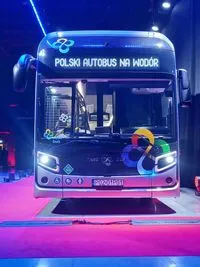NesoBus provides update on hydrogen-powered bus in Poland
NesoBus is developed from scratch as a hydrogen-powered vehicle, which is not a transformed or modified combustion or battery-powered vehicle.

NesoBus is a brand new, zero-emission, hydrogen-powered city bus from Poland created by Polish designers and engineers, working together with partners from Europe and from other parts of the world.
The bus is 12-meters-long and can carry up to 93 passengers, which includes 37 seats. Its operating range is around 450 km on one tank. It does not emit any exhaust fumes but purifies the air, with vapour being the only emission. NesoBus – the Polish hydrogen-powered bus – has been developed from scratch as a hydrogen-powered vehicle – it is not a transformed or modified combustion or battery-powered vehicle. Serial production is planned to start in 2023 in the factory which is being constructed in Swidnik, in eastern Poland.
NesoBus is an ideal solution for the inhabitants of cities – it eliminates the emission of harmful substances – apart from CO2, such substances mainly include nitrogen oxide or PM 2.5 fine particulate matter.
NesoBus, the Polish hydrogen-powered bus, is an electric vehicle with an electric motor. It generates electricity with the use of a fuel cell, using hydrogen as the fuel. The bus has its own “mini power plant.”
The brand name of our hydrogen bus, “Neso”, is an acronym of the Polish phrase ”Nie Emituje Spalin i Oczyszcza” (Does Not Emit Exhaust Fumes and Purifies the Air). NesoBus range is 450 km, refueling takes only 15 minutes. Thus the fully-ecological NesoBus does not waste many hours on battery charging. Instead of being parked for charging for many hours, it can drive continuously. NesoBus is very efficient – it uses 8 kg of hydrogen per 100 km on average. The capacity of its tanks is 37.5 kg of hydrogen which allows the bus to drive about 450 km on one tank. During the SORT-2 test the average consumption was 5.5 kg of hydrogen per 100 km.
NesoBus can also boast of excellent dimensions and capacity: length – 12 meters, width -2.55 meters, height – 3.4 meters and curb weight of less than 13 tons, which enables it to carry up to 93 passengers, including 37 seats.
The structure has been developed from scratch, with a hydrogen-powered bus in mind, and includes options to cater to the needs of respective cities and carriers.
The bus has a modular structure, so we are able to accommodate it to the needs of specific cities. We employ 25 engineers who can adapt the bus to the needs of respective cities and carriers.
NesoBus has been developed by the best and the most experienced engineers from Poland, in cooperation with partners from Europe and other parts of the world.
The bus is made of very high-quality components. Its exterior and interior have been designed by Torino Design of Italy, a company specialising in design work for the automotive industry. Fuel cells come from the world leader, Ballard, while hydrogen tanks are manufactured by Hexagon, a specialist in this field.
Following 65 days of intensive field and laboratory testing, which included 40 tests of various types, conducted in Poland and abroad, in April 2022, NesoBus has been granted the European vehicle type approval.
The company is building a factory in Poland, in the town of Swidnik. Its production capacity will be in excess of 100 buses per year. The factory will start operating next year.